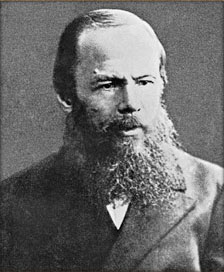Background
Dostoevsky was prompted to write the story by a journalist’s reaction to the first instalments of the Diary of a Writer. At the time, Dostoevsky edited the newspaper-magazine “The Citizen”, where the first chapters of the Diary were printed. The liberal newspaper “The Voice” published a response to the Diary written by the journalist L. K. Panyutin (writing under the pseudonym Nil Admirari). Dostoevsky’s attention was piqued by one passage in particular:
“The Diary of a Writer” reminds one of the famous diary that ends with the exclamation “Still, the Algerian Bey has a bump on his nose!” Nikolai Gogol’s short story “Diary of a Madman”. It is enough to look at the portrait of the author, currently exhibited at the Academy of Arts, in which we feel for Mr. Dostoevsky the very “pity” that he so inappropriately mocks in his magazine. This is a portrait of a person exhausted by a serious illness.
The narrator of “Bobok” responds to the journalist at the beginning of the story, among a stream of apparently random polemics:
I am not offended, I am a timid man; but, nevertheless, they made me out to be mad. An artist happened to paint a portrait of me: “After all,” he says, “you are a writer.” So I let him have his way, and he put the portrait on exhibit. And now I read: “Go and look at this sickly, almost insane face.” Well, let it be so, but do they have to say it so directly in print? Everything that appears in print should be noble; ideals are necessary, but here …
The portrait is alluded to again in the closing sentences of “Bobok”, as Ivan Ivanovich contemplates publishing an account of his experience: “I will take it to “the Citizen”. One of the editors there also had his portrait exhibited.” Dostoevsky was not merely concerned with drawing attention to the journalist’s tactlessness. As in Gogol’s story, the abrupt, disjointed style of the narration and the qualities of the narrator’s experience suggest a man on the brink of madness, although there is an implication that it is related to alcoholism rather than the epilepsy from which Dostoevsky suffered.
The narrator’s polemic on the subject of astonishment seems to be aimed at Panyutin’s pseudonym Nil Admirari (nihil admirari, “not to be surprised at anything” – Horace). According to Ivan Ivanovich:
It’s ridiculous, of course, to be surprized at everything, while being surprized at nothing is much more attractive and for some reason is considered good form. But it is hardly so in reality. In my opinion, being surprised at nothing is much more stupid than to be surprized at everything. And besides, to be surprized at nothing is almost the same as to respect nothing. A stupid person isn’t capable of respect.
The cemetery setting and dialogue was in part a satirical response to Panyutin. In 1870, Panyutin published a feuilleton in “The Voice” dedicated to the festivities at the Smolensk cemetery. The main character of the feuilleton also observes the behavior of the crowd in the cemetery, analyzes the “drunken” conversations of the still living people, and then, tired, decides to rest on one of the graves, having previously asked permission from the deceased. The dead man, allowing the weary observer to take a nap on his grave, enters into conversation with him, inquiring about the latest news from the living world.
Subtitle and sequel
“Bobok” was the 6th article to appear in Dostoevsky’s Diary, in 1873 – the first year of its publication. Probably prompted by Panyutin’s comparison of the Diary of a Writer to Gogol’s Diary (Запискам, zapiskam) of a Madman, Dostoevsky gave “Bobok” the subtitle “Notes (Записки, zapiski) of a Certain Person”. At the top of the article he wrote:
On this occasion I shall include “The Notes of a Certain Person.” That person is not I, but someone else entirely. I think no further foreword is needed.
The 8th article of 1873 is entitled “A Half-Letter from ‘A Certain Person’ “, which the author of the diary describes as being by “that same ‘person’, the very one who has already once distinguished himself in The Citizen on the subject of graves.” The author of the diary discusses, in an exasperated tone, this “person”, who has written him a long and convoluted letter in which he attacks and admonishes all sorts of people, particularly those in publishing, including the letter’s addressee. The diary’s author agrees to publish the letter, partly in an effort to finally appease and get rid of the “person”. He refuses to publish the first half of the letter due to its excessive vitriol, so it begins halfway through, in the middle of a sentence.
